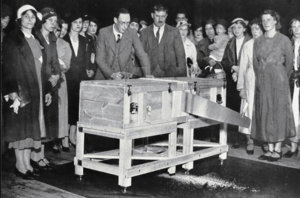P. T. Selbit facts for kids
Quick facts for kids
P. T. Selbit
|
|
|---|---|
 |
|
| Born |
Percy Thomas Tibbles
17 November 1881 London, England
|
| Died | 19 November 1938 |
| Nationality | English |
| Occupation | Magician |
P. T. Selbit (1881–1938) was a famous English magician, inventor, and writer. He is best known for being the first person to perform the amazing illusion of sawing a woman in half on stage. Magicians admired him for his clever ideas and his ability to create many popular stage tricks.
Contents
Early Life and Amazing Tricks
P. T. Selbit was born Percy Thomas Tibbles in Hampstead, London. When he was young, he worked for a silversmith. The basement of the shop was rented by a magician named Charles Morritt. Young Percy would sneak in to watch Morritt develop new magic tricks.
Percy became interested in magic and started performing coin and card tricks. He created his stage name, P. T. Selbit, by spelling his last name backwards and removing one "B." He also wrote about magic, including a handbook and editing a magazine for magicians.
Between 1902 and 1908, Selbit performed in music halls as "Joad Heteb." He dressed up in robes and a wig to look like an "Egyptian" character. This showed his talent for inventing new acts and his desire to keep audiences excited.
In 1910, Selbit toured with a trick called "Spirit Paintings." In this illusion, audience members would name an artist, and then mysterious pictures in that artist's style would appear on canvases. His next tour featured "The Mighty Cheese." People tried to tip over a huge model of a cheese wheel, but they couldn't because it secretly contained a gyroscope.
In 1912, Selbit began working with famous British magicians John Nevil Maskelyne and David Devant. He toured with Devant's "Window of a Haunted House" trick. In 1914, Selbit introduced his own "Walking through a Wall" illusion at St. George's Hall in London.
Selbit and Harry Houdini
In 1913, Selbit performed his "Walking Through a Brick Wall" illusion in London. A year later, the famous American magician Harry Houdini performed a similar trick in New York.
Some of Selbit's friends believed Houdini had seen Selbit's act and copied it. Houdini said he had bought the rights to the illusion from someone else. Selbit disagreed, saying he was the original creator, which led to a disagreement between the two magicians.
In Selbit's trick, a young lady walked through the wall. Houdini, however, walked through the wall himself. The secret to the illusion was a trapdoor hidden underneath the wall.
The Sawing Illusion: A New Era of Magic
The illusion of sawing a person in half has many versions. While some say the idea goes back to ancient Egypt, P. T. Selbit is known as the first magician to perform it publicly. He first showed the trick at the Finsbury Park Empire theatre in London on January 17, 1921. Before that, he showed it to a small group of promoters in December 1920 to get bookings.
In Selbit's version, a female assistant got into a wooden box, like a coffin but a bit bigger. Ropes tied her wrists, ankles, and neck. The box was then closed. Selbit sawed through the middle of the box with a large hand saw. The audience believed the assistant's body must have been in the saw's path. Finally, the box was opened, and the assistant, still tied, was perfectly fine!
This trick was a huge hit and made Selbit very popular. It came at a time when people were ready for new and exciting magic. The world had changed after the First World War, and audiences wanted something shocking and modern.
Other magicians quickly tried to copy and improve Selbit's trick. American magician Horace Goldin soon presented a version where the assistant's head, hands, and feet were visible throughout the trick. Goldin even tried to stop Selbit from performing his own trick in America by registering many similar names for the act. Selbit had to call his act "The Divided Woman," which sounded less exciting. Selbit tried to sue Goldin, but the lawsuit failed because Goldin's trick was ruled to be different enough.
The sawing illusion continued to develop. Goldin later created versions without a box and even used a large buzzsaw. Selbit is remembered for being the first to present this iconic trick, shaping how people saw stage magic for many years.
Modern Performances of the Sawing Trick
In the 1990s, the famous English magician Paul Daniels performed a tribute to Selbit on his TV show Secrets. He showed the original sawing a woman in half illusion, just as Selbit did. Daniels also included Selbit's later idea of using panes of glass, making it look like the woman's head, legs, and body were cut in half vertically.
Later Career and Other Illusions
After his legal battles in America, Selbit returned to Britain in 1922. He focused on creating new illusions, hoping to find another trick as famous as sawing. He invented tricks like Girl/Man without a Middle (1924), Through the Eye of a Needle (1924), The Million Dollar Mystery, Stretching a Girl, and Avoiding the Crush. He also created Selbit's Blocks and possibly the Siberian Chain Escape. While many of his tricks were clever and performed by other magicians for years, none became as famous as his sawing illusion.
In 1928, Selbit helped his old mentor, Charles Morritt. Morritt had been arrested due to a misunderstanding about his "Man in a Trance" act. Selbit and fellow magician Will Goldston helped pay for Morritt's defense, and he was found not guilty.
Books by P. T. Selbit
- The Magician's Handbook (1901)
- The Magical Entertainer (1906)
- Conjuring Patter (1907)
- The Magic Art of Entertaining (1907)
- From 1905 to 1910, he edited a magic magazine called The Wizard. This magazine later became The Magic Wand under a different editor.


